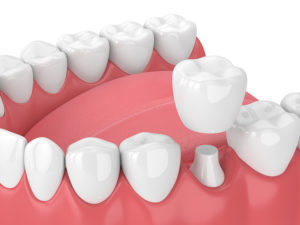Will my dental crown be noticeable?


Materials Make a Monumental Difference
Before the use of porcelain, metal crowns ruled the day. Back teeth may have received a gold or metal crown while teeth in the smile line often received crowns made from porcelain fused to metal. This was the best thing available, but could result in a visible dark line where the crown and tooth base meet.
While metals are still used today, especially for teeth not easily seen, porcelain dental crowns have grown in popularity for many reasons.
Porcelain crowns are strong, long lasting, and aesthetically pleasing. Your dentist has the capability of placing a crown that so closely resembles neighboring teeth, it is virtually impossible to detect a crowned tooth.
Your dentist may discuss an onlay or inlay … these are crowns that require less of your tooth’s structure to be removed and are often placed on teeth with decay to protect and strengthen the tooth.
Dental Crowns Serve Many Useful Purposes
If a tooth is broken, a dental crown allows your dentist to save your tooth from being extracted.
A severely decayed tooth can be protected from loss or further damage when covered with a crown.
A dental crown is often the final step to complete a root canal. With endodontic treatment, an access point is needed to clean out the root canals. Very often this access point is permanently sealed with a dental crown.
Patients who opt for a fixed prosthesis may require adjacent abutment teeth to be crowned to attach a partial or bridge.
Following tooth loss, patients who select a dental implant will complete treatment with a crown that will be secured to the implant abutment.
Caring for a tooth that has received a crown is as easy as what you do for all your teeth. Brush twice daily with fluoridated toothpaste and floss daily. Your dentist will demonstrate how to floss around a crowned tooth.
Visit our dental team every six months for cleaning and exam. It is important to remember that although a crown has allowed your dentist to save your tooth, proper care is needed to prevent gum disease from developing.